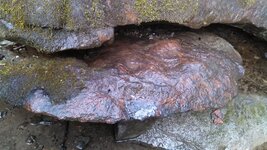I ran into this possible meteorite a little while ago and I had a very hard time getting a chip off of it to test. I finally got around to testing the small chip with DMG and the swab did turn pink. It wasn't an overwhelming color change, and the color didnt change on every single spot. Could it not have had a dramaticly change because I could only test the severely weathered edge chip? Has anyone else tested an iron meteorite with DMG? Should the swab turn heavily pink on every spot of the meteorite if it is one?
I think I'm making out what could have possibly been regmaglypts on it. Should I go back and get this guy or what? Meteoright or meteorwrong?

What else could it be looking like that?
edit: oh and its magnetic
I think I'm making out what could have possibly been regmaglypts on it. Should I go back and get this guy or what? Meteoright or meteorwrong?

What else could it be looking like that?
edit: oh and its magnetic
Amazon Forum Fav 👍
Last edited:





